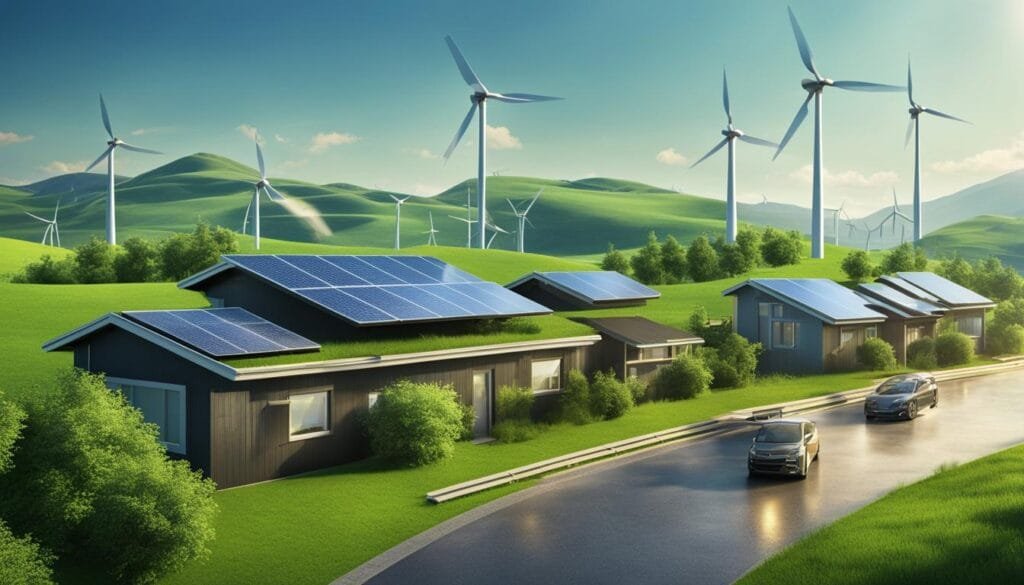When it comes to investing, it’s important to consider the impact of climate change on your portfolio. As the global climate continues to change, it can have significant effects on various sectors and industries. Companies that are taking action to mitigate climate risk and invest in climate resilience are poised to perform well in the long term. Investing in climate change stocks and building a weatherproof portfolio can help investors navigate the challenges and opportunities presented by the changing climate.
Key Takeaways:
- Considering climate change is essential for investment stability
- Companies investing in climate resilience are likely to perform well
- Climate change stocks can help navigate the challenges caused by climate change
- Building a weatherproof portfolio is crucial in the age of climate change
- Investing in sectors focused on climate resilience provides long-term benefits
The Importance of Climate-Aware Investing
Climate-aware investing is a crucial approach for investors in today’s rapidly changing world. As climate volatility increases and the transition to a low-carbon economy gains momentum, it is essential to consider the risks and opportunities posed by climate change in investment decision-making.
By incorporating climate-risk investments and climate-resilient investments into portfolios, investors can position themselves to navigate the challenges and capitalize on the opportunities presented by the changing climate. Climate-risk investments involve identifying companies and sectors that are vulnerable to climate-related risks, such as extreme weather events and regulatory changes. On the other hand, climate-resilient investments focus on companies and sectors that are taking proactive measures to address and adapt to climate change, such as renewable energy and sustainable agriculture.
One way to integrate climate awareness into investment strategies is by assessing climate risk in portfolio construction. This involves analyzing the exposure of different assets to climate-related risks and adjusting the allocation accordingly. By diversifying investments across sectors and geographies, investors can mitigate the impact of climate volatility on their portfolios. Additionally, engaging with companies on climate-related issues can help drive positive change and encourage sustainability practices.
“Investing in climate-resilient sectors such as renewable energy and sustainable agriculture can provide long-term stability and contribute to a more sustainable and resilient global economy.”
Table: Climate Resilient Investments vs. Climate-Risk Investments
| Climate Resilient Investments | Climate-Risk Investments |
|---|---|
| Renewable energy | Fossil fuel companies |
| Sustainable agriculture | Water-intensive industries |
| Energy-efficient technologies | Carbon-intensive sectors |
| Green infrastructure | Companies with high carbon emissions |
By adopting climate-aware investing practices and building a portfolio that incorporates climate-resilient investments, investors can not only mitigate the risks associated with climate change but also contribute to a more sustainable and resilient global economy. Understanding the importance of climate-aware investing and taking proactive measures can lead to long-term investment stability and aligning investments with a more sustainable future.

Building a Green Investment Portfolio
Investing in a green investment portfolio is not only a way to align your investments with your values but also a strategy for long-term stability and growth. By focusing on stable green investments, which prioritize sustainability and environmental responsibility, you can contribute to a more sustainable future while potentially benefiting from their long-term growth and stability.
When building a green investment portfolio, it’s important to consider sectors that are driving the transition towards a low-carbon economy. These sectors include renewable energy, clean technology, and sustainable agriculture. By allocating a portion of your portfolio to these green investments, you can support companies that are at the forefront of addressing climate change and capitalizing on the opportunities it presents.
One way to identify stable green investments is by looking for companies that prioritize sustainability in their business practices. This can include investing in renewable energy companies that generate electricity from clean sources such as solar or wind power. Sustainable agriculture companies that prioritize regenerative farming practices and reduce carbon emissions can also be attractive green investment options.
Benefits of Building a Green Investment Portfolio
- Long-term growth: Green investments have the potential for long-term growth as the world shifts towards a more sustainable and low-carbon future.
- Reduced environmental impact: By investing in companies that prioritize sustainability, you can contribute to reducing carbon emissions and other harmful environmental impacts.
- Resilience: Green investments tend to be more resilient in the face of climate-related risks and regulatory changes, providing stability in an uncertain world.
In conclusion, building a green investment portfolio can offer stability, growth, and the opportunity to make a positive impact on the environment. By investing in stable green investments that prioritize sustainability and environmental responsibility, you can align your investments with your values while potentially benefiting from the long-term growth and stability of these sectors.
Adapting to the Investment Climate
As the investment landscape continues to evolve, it is crucial for investors to adapt to the changing climate. Climate volatility, driven by factors such as extreme weather events and the transition to a low-carbon economy, can have significant impacts on investment portfolios. This necessitates the practice of climate-aware investing, where investors consider climate risks and opportunities in their decision-making process.
Investment Climate Adaptation involves recognizing the risks posed by climate change and taking proactive steps to mitigate them. This can include diversifying investments across sectors and asset classes to reduce vulnerability to climate-related shocks. By incorporating climate factors into portfolio construction, investors can better position themselves to navigate the challenges and seize the emerging opportunities driven by climate change.
“Climate-aware investing allows investors to not only protect their portfolios from climate-related risks but also capitalize on the potential growth and stability offered by climate-resilient sectors.”
Engaging with companies on climate-related issues is another crucial aspect of climate-aware investing. By actively participating in shareholder advocacy and supporting companies that prioritize climate resilience, investors can influence corporate behavior and contribute to a more sustainable future. This engagement can also provide investors with valuable insights into the climate strategies and risk management practices of the companies in which they are invested.
Investment Climate Adaptation: A Key to Resilient Portfolios
Investment climate adaptation is essential for building resilient portfolios in the face of climate volatility. As the effects of climate change become increasingly evident, incorporating climate-aware investing practices can help investors navigate the risks and capitalize on the opportunities presented by the changing climate. By diversifying investments, considering climate factors in portfolio construction, and engaging with companies on climate-related issues, investors can adapt their strategies to mitigate risk and position themselves for long-term success in a climate-resilient economy.
Investing in Renewable Energy
Investing in renewable energy is a crucial component of climate-resilient investments. With the cost of renewable power generation decreasing rapidly, it has become an attractive investment opportunity for those looking to contribute to a sustainable future while potentially experiencing long-term growth and stability. Renewable electricity growth is accelerating worldwide, supporting the emergence of a new global energy economy. By investing in renewable energy companies and funds, investors can play a vital role in the transition to a low-carbon future.
Renewable energy investments offer several advantages. Firstly, they contribute to the reduction of greenhouse gas emissions, helping combat the effects of climate change. Secondly, the growth potential of renewable energy companies is significant, as the demand for clean and sustainable energy continues to rise. This growth is driven by both regulatory incentives and increasing consumer demand for environmentally friendly alternatives.
Renewable energy investments span various sectors such as solar, wind, hydro, and geothermal power generation. These sectors offer diversified investment opportunities, allowing investors to tailor their portfolios to their risk tolerance and investment objectives. Table 5 provides a summary of the renewable energy sub-sectors and their growth potential based on recent market trends and forecasts.
| Renewable Energy Sub-Sector | Growth Potential |
|---|---|
| Solar Power Generation | High |
| Wind Power Generation | Medium |
| Hydro Power Generation | High |
| Geothermal Power Generation | Medium |
As shown in Table 5, solar and hydro power generation offer high growth potential, making them attractive investment options. Wind power generation also presents a medium growth potential, driven by advancements in technology and the increasing adoption of renewable energy sources by governments and businesses worldwide. Geothermal power generation, although less prominent, still offers a stable investment opportunity.

Investors seeking climate-resilient investments can consider allocating a portion of their portfolio to renewable energy. By doing so, they not only support the global transition to cleaner and more sustainable energy sources but also potentially benefit from the long-term growth and stability of the renewable energy sector.
The Role of Agriculture in Climate-Resilient Investing
Climate volatility poses significant challenges to the agricultural sector, impacting crop production and leading to potential losses. However, research has shown that implementing crop switching strategies can help mitigate these risks and enhance climate resilience in agriculture. Crop switching involves shifting from traditional crops to those better suited to changing climate conditions, reducing vulnerabilities and improving overall stability.
Table:
| Crop | Climate Conditions | Advantages |
|---|---|---|
| Wheat | Drought-prone regions | Drought tolerant and water-efficient |
| Corn | Warmer climates | Tolerates heat and requires less water |
| Quinoa | Higher temperatures and arid conditions | High nutritional value, adapts well to dry environments |
By investing in companies and funds that focus on climate-resilient agriculture and promote sustainable farming practices, investors can support the agricultural sector’s resilience while potentially benefiting from its long-term stability. These investments not only contribute to a more sustainable food system but also align with the growing consumer demand for environmentally friendly and socially responsible practices.
“Investing in climate-resilient agriculture not only mitigates climate-related risks but also opens up opportunities for sustainable growth and positive impact. By supporting companies that prioritize adaptive farming techniques and sustainable resource management, investors can contribute to a more resilient and secure food supply chain while achieving long-term financial objectives.”
Potential Risks and Considerations in Climate-Aware Investing
While climate-aware investing offers opportunities for growth and stability, it is important for investors to be aware of potential risks and considerations. By understanding and assessing these risks, investors can make informed decisions to protect and optimize their portfolios. Some key risk considerations in climate-aware investing include:
Interest Rate Risk
Interest rate risk is an important factor to consider when investing in climate-aware portfolios. When interest rates rise, bond prices typically fall, which can negatively impact fixed-income investments. As climate-aware investments often involve long-term strategies, it is essential for investors to monitor interest rate trends and adjust their portfolio accordingly to mitigate this risk.
Sector Investments
Investing in specific sectors related to climate resilience can offer significant growth potential. However, it is crucial to acknowledge that sector investments can be more volatile compared to diversified investments. Changes in government policies, technological advancements, and market conditions can have a significant impact on specific sectors. Therefore, investors should carefully consider the risks associated with sector investments and ensure proper diversification within their portfolios.
Emerging Markets
Investing in emerging markets can provide exposure to regions with high growth potential. However, it is important to recognize that emerging markets often come with additional risks. Political uncertainties, economic instability, and currency fluctuations can pose challenges for investors. Adequate research, due diligence, and risk management strategies are essential when investing in emerging markets as part of a climate-aware portfolio.
By carefully assessing these risks and considering them in investment decisions, investors can create resilient climate-aware portfolios that balance growth potential with risk mitigation. It is also important to regularly review and adjust portfolios based on changing market conditions and risk profiles, ensuring a robust and adaptable investment strategy.
Conclusion
In conclusion, climate change is a significant factor that can impact investment stability. By adopting climate-aware investing practices, building a green investment portfolio, and staying informed about climate-related risks and opportunities, investors can weatherproof their portfolios for the future.
Investing in climate-resilient sectors such as renewable energy and climate-resilient agriculture can provide long-term stability and contribute to a more sustainable and resilient global economy. These sectors are poised for growth as the world transitions towards cleaner and more sustainable sources of energy and adapts to the changing climate.
It’s important for investors to carefully consider risk factors and engage with companies and funds that prioritize climate resilience and sustainability. This includes assessing environmental policies, climate risk management strategies, and the overall commitment of companies to mitigating climate change and addressing its impact. By aligning investments with climate-conscious companies, investors can not only protect their portfolios but also contribute to a better future for our planet.
FAQ
Is climate change a significant factor to consider when investing?
Yes, climate change can have significant effects on various sectors and industries, making it important to consider its impact on your portfolio.
What is climate-aware investing?
Climate-aware investing involves considering the risks and opportunities posed by climate change when making investment decisions, including the increasing frequency of extreme weather events and the transition to a low-carbon economy.
How can I build a green investment portfolio?
To build a green investment portfolio, you can invest in companies and funds that prioritize sustainability and environmental responsibility, focusing on sectors such as renewable energy, clean technology, and sustainable agriculture.
How can I adapt my investment strategy to the changing investment climate?
By incorporating climate-aware investing practices, such as considering climate risk in portfolio construction and engaging with companies on climate-related issues, you can adapt your investment strategy to mitigate risk and capitalize on emerging opportunities.
What are the benefits of investing in renewable energy?
Investing in renewable energy can contribute to the transition to a low-carbon future while potentially experiencing long-term growth and stability, as the cost of renewable power generation decreases and renewable electricity growth accelerates worldwide.
Why is agriculture important in climate-resilient investing?
Agriculture plays a critical role in climate-resilient investing because climate volatility can significantly impact agricultural production and crop yields. By investing in climate-resilient agriculture and sustainable farming practices, you can support the resilience of the agricultural sector while potentially benefiting from its long-term stability.
What are the potential risks and considerations in climate-aware investing?
Some potential risks and considerations in climate-aware investing include interest rate risk, sector volatility, and additional risks when investing in emerging markets. It’s important to carefully assess these risks and consider them in your investment decisions.
How can climate-aware investing help weatherproof my portfolio?
Climate-aware investing can help weatherproof your portfolio by considering climate risk, investing in climate-resilient sectors, and staying informed about climate-related risks and opportunities. By doing so, you can position your portfolio for long-term stability and contribute to a more sustainable and resilient global economy.
How Can Investing in Climate Change Combat Climate Change?
Investments combating climate change play a crucial role in combating the global crisis. By allocating financial resources towards renewable energy projects, sustainable agriculture, and green infrastructure, we can significantly reduce greenhouse gas emissions. Such investments promote clean technologies and encourage the transition towards a low-carbon economy, ultimately aiding in the fight against climate change.


Pingback: Reaping What We Sow: The Future of Agricultural Investments in a Changing Climate! – Straight Fire Money